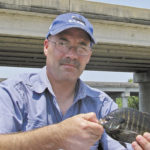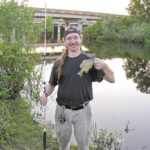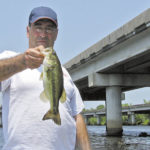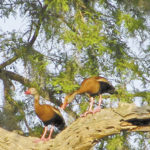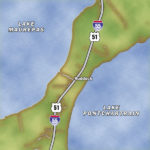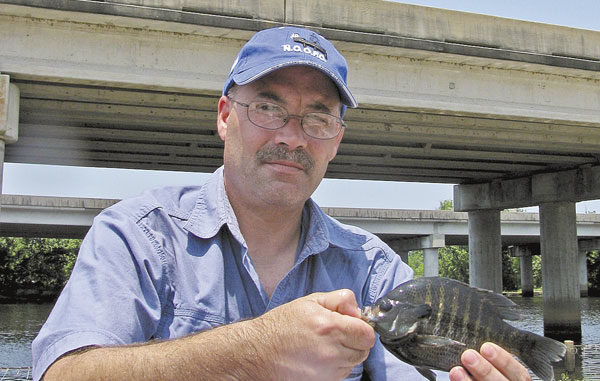
This road between LaPlace and Manchac is like a giant fishing pier providing access to fantastic small-boat action.
Doc Fontaine’s brother-in-law of the month was visiting South Louisiana from Oregon for a wedding. He also wanted to squeeze in some of the fabulous fishing Doc had been preaching about since they’d met a year earlier. For this purpose, Spencer, an “environmental organizer” (not to be confused with a “community organizer,” he’d explained to a highly amused Eddie at a dinner party two nights earlier), had brought along his fly rod-and kayak.
With such equipment on hand, it seemed fitting to escort Spencer toward some classically gorgeous South Louisiana swamp panorama. As luck would have it, Doc had just become partners in a “camp” on the Blood River, where we were headed for the weekend, courtesy of Artie and his SUV.
Alas, on this Friday afternoon, we felt compelled to make a pit stop on the way.
“You’ll love this place, Spence,” Artie nodded smugly from the driver’s seat. “Heck, the very name Prop Stop should be a hint. You see, canoers and kayakers and like-minded environmentalists in this area felt they finally had to put their foot down.”
“Damn right,” Pelayo chimed in. “They felt compelled to organize and put on a consciousness-raising program to finally put a STOP to all those PROPELLER-driven boats! Those fossil-fuel sucking, carbon-spewing monsters — constantly polluting everything and tearing up our fragile wetlands with their wakes!”
“Well it’s about time!” Spencer smiled.
“These committed people,” Eddie said solemnly as Spence turned around to acknowledge him from the passenger seat. “Yes, these folks felt a sense of stewardship toward Louisiana’s unmatched natural bounty and beauty.”
We’d just passed Pass Manchac northbound on I-55, and Spence pointed out the window to emphasize the point.
“Oh yes, yes,” Spencer nodded as he looked around. “I know exactly what you mean.”
“So anyway,” Eddie continued. “These selfless and forward-looking folks established this place where we’re headed, originally as a meeting hall for environmentally oriented workshops and consciousness-raising sessions. In brief, they’d simply HAD it with all those blockheaded, power-boating macho-men yahoos roaring around in their shiny multicolored cigarette boats and ski boats.”
“Wonderful!” Spence gasped. He was all ears, smiling, nodding. “We certainly need many more such people to finally turn things around in this country. And from what you’re telling me, it looks like we might be getting there!”
“You bet, amigo!” Artie continued. “I’m sure you’re familiar with all those clowns in their fancy, shiny powerboats, always with the tanned beach-bunnies in their hoop-earrings and thong bikinis perched on the bow showing off.”
“Why yes, just yesterday in fact, while I was trying to paddle my kayak close to Mitch’s house in Slidell, some jet-skiers almost ran me down! TWICE! No consideration whatsoever! It almost seemed like they were doing it on purpose. I was dumbstruck as they kept circling and coming back around! Guzzling beer and laughing the whole time. I’d never seen anything like it!”
“Exactly,” Pelayo added. “And that’s what makes the place we’re now going so special. I mean a lot of people just got FED UP with all that power-boating, boozing, irresponsible foolishness. Our gorgeous swamps and wetlands — unique on this continent, as you know — shouldn’t be degraded and humiliated in such a manner. They deserve more respect. They deserve the proper reverence. As well as… .”
“This Prop Stop is now a quaint Paris-styled bistro,” Artie interrupted. “And features an organic menu, Spence. And strictly plays New Age music, Enya, Yanni, Tori Amos and tunes of that sort. And a fraction of every dollar you spend with them goes toward the Sierra Club.”
“But best of all!” Pelayo said with a broad smile of relief. “We’ll have a place blessedly free from all those yo-yos and rich yahoos — all those obnoxious jet-skiers and powerboaters and boozers and all their clowning and irresponsibility.”
“I really appreciate this!” Spencer seemed choked up, near tears. “Mitch told me I could count on you guys. And he’s never steered me wrong!”
Well, Spence lasted all of five minutes, then went outside to sulk. The combined horsepower parked behind and motoring around the Prop Stop probably surpassed 2 million.
A couple glasses of red wine at Doc’s new camp finally brought Spence around to appreciate (or at least tolerate) our “humor.”
Alas, the rain started as we finally turned off the Stones’ Hot Rocks and turned in, Eddie with a badly sprained ankle from trying a Mick karaoke, complete with dance steps. The rain continued through most of the night — not unusual for early summer in South Louisiana. This gave the gang a fabulous excuse to sleep in, and then get up, cook, BS, never wet a line, etc. — which is to say, the normal fishing camp goings on.
After all, as we all know, torrential rains play havoc with freshwater fishing. The rain roils the waters and raises the pH levels — or some such hocus-pocus. These same rains, on the other hand, actually seem to turn freshwater cats ON as well as certain panfish, especially in an overflow swamp, when the flooded sloughs start draining. Time to cash in, I figured.
To heck with the Blood and Tickfaw rivers. The 51 Canal, which runs from LaPlace to Ponchatoula alongside I-55, was close by and seemed like the ticket for what I had in mind. Can’t beat it for channel cats, the very fish turned on by rain, the very fish that love dirty water.
So time for some relaxing, late-morning fishing, I decided, paddling my ‘rogue around and casting my light spinning tackle toward the pilings (much like fishing the Lake Pontchartrain Causeway, but with lighter tackle and little corks here) then tussling with gorgeous (and delicious!) channel cats.
These fish spawn around late May in this area, and if you find water in the 4- to 5-foot range around the pilings, cast to them with fresh crawfish tails (from the little crawfish scooped up from surrounding ditches) on a plain hook under a cork, you’ll have a blast, along with the makings of some dy-no-mite po-boys.
Along this canal, something’s always biting on natural bait. So with a freshly scooped bucket of such morsels, I parked the truck off old Highway 51 at Shell Back Bayou, and paddled toward the pilings under the I-55 overpass — actually toward Shell Bank Bayou itself first, which meanders west from the 51 canal and eventually, after much shrinking and winding, reaches “the prairie” on the southeastern coast of Lake Maurepas. I at least wanted to try some cypress-knee fishing before I hit the bridge pilings.
As expected, the water was high and dirty, but I noticed little root beer-colored spills at the mouth of the sloughs emptying from this gorgeous cypress-tupelo swamp. I reached in the bucket for a prized grass shrimp, many of which ended up in the net along with miniature crawfish.
I say “prized” because everything hits grass shrimp, especially around here — bull bream, lakerunners, goggleye, yellow bass, sac-a-lait, catfish, choupique, even green trout.
You never know what you’ll pull out when you stick one (or two) of these little suckers on a skinny perch-hook 3 feet (because of the high water today) under a little bobber and cast next to the cypress knees or to the edge of the grass beds around here.
And it didn’t take long. On my third cast, the little cork actually smacked the tupelo trunk, then dropped in the water. It twitched twice and vanished.
“That’s him!” I howled to myself while rearing back on the ultra-light spinning rig, the little reel singing away. Whatever I had was going crazy, and it wasn’t all that small.
Sure enough, I soon yanked out and swung aboard a beaut’ of a bull bream, and chunked it in the bucket. I cast next with the same offering, near the same spot, and came up with another bream. Then my badly stretched and twisted line tangled on a cast, and my cork landed a good 10 feet from shore, barely in front of my ‘rogue. I was untangling the mess when I felt pressure.
Whoa! A little yellow bass soon came aboard. I noticed minnows erupting in the area, cast back with a little shrimp-tipped mini-jig and nailed three more yellow bass in short order.
“Spencer would probably enjoy this,” I thought to myself.
Then movement overhead caught my eye
“Nah, can’t be Mexican whistling ducks?” I thought. Must be ibis (bec-croche). Plenty of them in this area, and they fly similar to those Mexican whistlers.
Then I cast toward some grass beds, and latched into something bigger. Then it jumped. A nice little green trout! Next came a goggleye.
Then the thunder started, and 10 minutes later the sprinkles. I was just taking off a choupique when the heavy drops started.
“Time to get under the bridge, and into the catfish!” I said to myself while paddling back east. “Gimme, gimme shelter!” I howled as we neared the elevated spans. “The storm is threatening!”
Last night’s music was still ringing in my ears.
That’s the beauty of this fishing this time of year: You’re never more than a few seconds away from shelter; then you fish while you’re under it. I put my cork deeper here, about 5 feet, to get near the bottom for catfish. I also baited up with crawfish — a whole little one crushed, the top bait for channel cats in this area as I’ve found over the years. Oh, you’ll also catch cats on regular shrimp and nightcrawlers and chicken liver. But fresh crawfish always work best, in my experience.
More interestingly, local or ditch crawfish work best. One day I hit upon the ingenious idea of bringing along a couple of pounds of the dead ones from a sack we’d bought for a crawfish boil. They worked, but not nearly as well as the few I’d scooped up. Fascinating, and I’m sure some biologist can explain it.
With my depth finder (paddle), I finally located some pilings in the desired depth — 5 feet — and started casting. The first fish was another bull bream.
“Now here’s a cat!” I grunted on my fifth cast, as the fish hit the surface thrashing. Channel cats always seem to do this. They’re nothing like hardheads, which always hug the bottom.
The tussle raged for a minute or so, then I hauled aboard a 2-pound cat. Man, I could taste the golden-brown fillets already. And I came up with another one — not 20 seconds after my cork bounced off the next set of pilings and hit the water. This one was a bit smaller but plenty filletable.
The storm raged overhead, but I remained dry while catching cat after cat, mixed in with three more yellow bass. And for whatever reason, they bit best precisely during the heaviest portion of the storms. Always seems to happen this way. When I slid the ’rogue in the back of the truck, I counted 18 fish in the bucket. Then again some movement overhead jerked my gaze upward.
“Yes!’ I thought. “Those ARE Mexican whistlers.”
To make my point, they landed on a tall cypress just off the highway, and I zoomed in for a couple of pictures. Boy Spence would REALLY enjoy this, I thought to myself. Here’s a new species of waterfowl establishing — apparently, given the time of year — a breeding population in our wetlands. Best of all for us, as we’ve learned the past few seasons, these ducks are not only colorful but also dynamite in a gumbo.
In brief, for the kayaker, canoeist, piroguer, small-boater, no more convenient setting exists than the 51 Canal. Old Highway 51 provides roadside parking and literally dozens of “launch” sites. Check a map, and you’ll see that from LaPlace to Ponchatoula, every mile or so a slough crosses under the old highway through culverts. Nearly every such culvert crossing provides a handy-dandy place to throw your ‘rogue (or whatever) in the water and paddle into the main canal to fish in the blessed shade around the interstate pilings, similar to Causeway fishing.
Then Shell Bank Bayou and many smaller ones, going west toward Lake Maurepas, offer venues to the interior of this gorgeous swamp. On falling tides (check Pass Manchac), the smaller sloughs and finger-trenasses that empty into these bayous from the surrounding overflow swamp make for panfish hotspots. All those bugs, worms, little crawfish, tadpoles and minnows funnel through these chokepoints with the current, and the bull bream, lakerunners, yellow bass, channel cats, green trout (and yes, gar and choupique) gather for the feast.
On moving tides, those culverts themselves can provide good action for bank fishermen. Exhaustive interrogation of bank fishermen revealed that a falling tide makes for the hottest fishing. The area between Lake Pontchartrain and old Highway 51 is mainly overflow swamp with a few shallow ponds and bayous. So this figures. As mentioned above, on such a falling tide the goodies from the swamp are being funneled into the deeper waters of the 51 canal for a panfish feast.
I have it on good authority that some of the best fishing for big bass in this area comes during ferocious cold fronts when the water is rushing through the culverts. Extra-long worms or eel-like lures with heavy sinkers (to keep the bait deep) and cast ahead of the culverts on the west side of the road can produce large bass. The lure mimics the congo eels (amphibians) on which large bass feed in these swamps.
